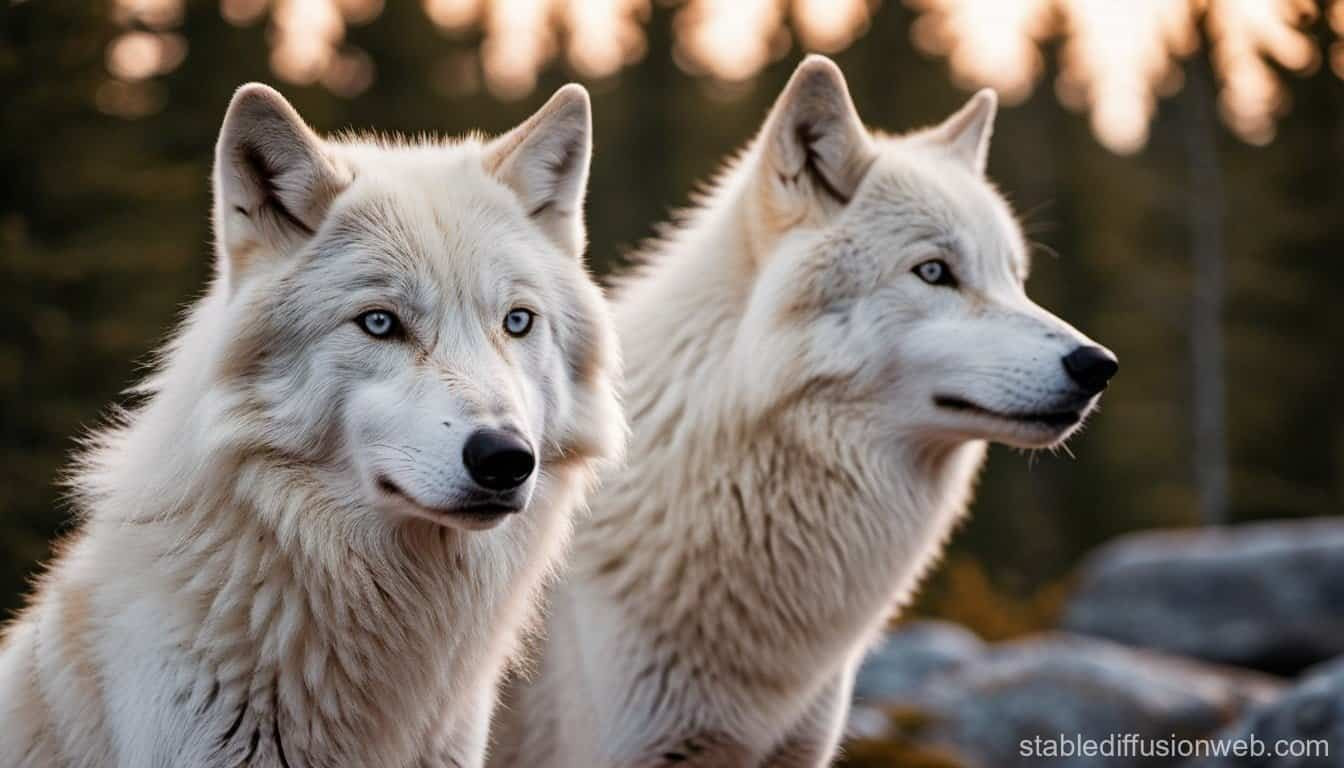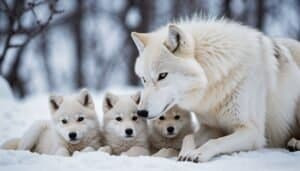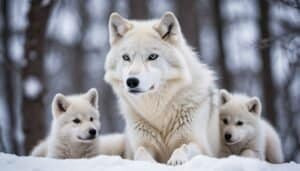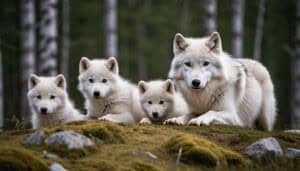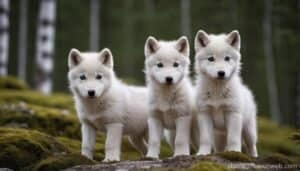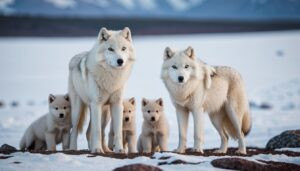Introduction
Understanding the role of the alpha pair in an Arctic wolf pack is crucial to comprehending the pack’s social structure and survival strategies
This article will explore the various responsibilities and roles of the alpha pair, their social interactions within the pack, the process of succession and selection, and their influence on the overall health and cohesion of the pack. By delving into these aspects, we gain a deeper appreciation of the intricate dynamics that govern Arctic wolf packs
Responsibilities and Roles of the Alpha Pair
The alpha pair in an Arctic wolf pack plays a crucial role in the overall functioning and survival of the group
Their responsibilities extend beyond merely leading the pack; they encompass maintaining dominance, ensuring reproductive success, and coordinating hunting strategies. These roles are vital for the stability and efficiency of the pack
Leadership and Dominance
The alpha pair, typically the strongest and most experienced wolves in the pack, are responsible for maintaining order and hierarchy. Their leadership is established through displays of dominance and strength, ensuring that subordinate wolves respect their authority
This dominance is not only physical but also behavioral, with the alpha wolves setting the tone for pack interactions and activities
The alpha male often leads the pack during hunts and territorial patrols, using his experience to navigate the harsh Arctic environment. His role as the primary defender of the pack’s territory is critical in warding off rival packs and other predators
The alpha female, while also involved in these activities, primarily focuses on the care and protection of the pups, ensuring the continuation of the pack’s lineage
Reproductive Roles
Reproduction within the pack is primarily the domain of the alpha pair. The alpha female is typically the only female to breed, which helps control the pack’s size and ensures that resources are adequately distributed among the members
This exclusivity in breeding prevents conflicts and competition among the females and maintains genetic diversity within the pack
The alpha female’s role extends beyond giving birth; she is also the primary caregiver for the pups. Her responsibilities include nursing, grooming, and protecting the young wolves from potential threats. The alpha male supports her by providing food and guarding the den site, ensuring that the pups grow up in a safe and nurturing environment
Hunting Strategies
Effective hunting is essential for the survival of the Arctic wolf pack, and the alpha pair plays a pivotal role in this aspect. The alpha wolves coordinate and lead hunting expeditions, using their experience and knowledge of the terrain to track and capture prey
Their leadership ensures that the pack works together efficiently, maximizing their chances of a successful hunt
The alpha pair’s strategy often involves complex tactics and teamwork, where each member of the pack plays a specific role. The alpha male typically initiates the chase, while other pack members assist in cornering and bringing down the prey
The alpha female may participate directly in the hunt or stay back to protect the pups, depending on the situation
By leading and organizing the hunt, the alpha pair ensures that the pack has a steady supply of food, which is crucial for the wolves’ survival in the harsh Arctic environment. Their ability to adapt to changing conditions and prey availability demonstrates their critical role in the pack’s success
Social Dynamics and Interactions
The social structure within an Arctic wolf pack is intricate and highly organized, largely influenced by the interactions and behavior of the alpha pair
These dynamics are essential for maintaining harmony and cooperation among the pack members, ensuring the pack’s overall stability and effectiveness in survival
Interactions with Subordinates
The alpha pair’s interactions with subordinate wolves are critical in establishing and maintaining the social hierarchy within the pack. Subordinate wolves look to the alpha pair for guidance and leadership, which is reinforced through various social behaviors and rituals
These interactions help prevent conflicts and ensure that each member knows their place within the pack
Subordinates often show submissive behaviors towards the alpha pair, such as lowering their bodies, tucking their tails, or licking the alpha’s muzzle. These displays of submission reinforce the alpha’s dominance and help maintain order within the pack
In return, the alpha pair provides protection, guidance, and opportunities for subordinates to learn and contribute to the pack’s success
The alpha pair also plays a role in mediating conflicts between subordinate wolves. By intervening in disputes and asserting their authority, the alpha wolves help prevent serious altercations and maintain social cohesion
This conflict resolution is crucial for the pack’s harmony and effectiveness as a unit
Protection and Defense
Protection and defense are vital responsibilities of the alpha pair, ensuring the pack’s safety from external threats. The alpha male, in particular, is often at the forefront of defending the pack’s territory against rival wolves, predators, and other dangers
His role as the primary defender involves marking territory, patrolling boundaries, and engaging in confrontations when necessary
The alpha female also contributes to the pack’s defense, particularly in protecting the pups and the den site. Her vigilance and protective instincts are crucial in ensuring the safety and well-being of the youngest and most vulnerable pack members. By working together, the alpha pair creates a secure environment where the pack can thrive
Additionally, the alpha pair’s leadership in defense extends to coordinating the pack’s response to threats. Whether facing rival wolf packs, predators like polar bears, or environmental challenges, the alpha wolves’ ability to rally and direct the pack’s efforts is essential for survival
Their experience and strategic thinking enable the pack to respond effectively to various threats, ensuring the pack’s continued existence
Succession and Selection Process
The succession and selection process for the alpha pair in an Arctic wolf pack is a critical aspect of maintaining the pack’s continuity and stability
This process involves specific criteria and behaviors that determine how new leaders emerge and assume their roles within the pack
Criteria for Selection
The selection of new alpha wolves typically involves a combination of physical strength, intelligence, and social skills. Potential alpha candidates must demonstrate their ability to lead and protect the pack. This often means engaging in displays of dominance and participating in critical pack activities such as hunting and territorial defense
Experience plays a significant role in the selection process. Wolves who have shown their capability over time, perhaps by excelling in hunts or displaying strategic thinking in conflicts, are more likely to be considered for leadership
The existing alpha pair might also play a role in grooming their successors, subtly guiding and mentoring promising candidates
Additionally, the selection process may involve challenges from other pack members. Aspiring alphas might have to assert their dominance through displays of strength or direct confrontations with current leaders or other contenders
These confrontations, while sometimes aggressive, are part of the natural selection process that ensures the strongest and most capable wolves lead the pack
Process of Succession
Succession in an Arctic wolf pack usually occurs when the current alpha pair becomes too old, weakened, or dies. The transition of power can be a turbulent time for the pack, as different members vie for the leadership position
The new alpha pair often emerges through a combination of displays of dominance, strategic alliances, and, in some cases, direct challenges
In some cases, a subordinate wolf may challenge the existing alpha for leadership. These challenges can lead to fights, where the stronger and more dominant wolf prevails and takes over the alpha role
If the alpha wolf is deposed, they might remain in the pack in a subordinate position, leave to join another pack, or become a lone wolf
The new alpha pair, once established, must quickly assert their dominance and stabilize the pack. This involves reinforcing the social hierarchy, maintaining territorial boundaries, and ensuring that the pack’s activities, such as hunting and raising pups, continue smoothly
The transition period is crucial for the new alpha pair to demonstrate their capability and gain the pack’s trust and respect
The smooth succession of leadership is vital for the pack’s cohesion and survival. Successful transitions ensure that the pack remains strong and organized, capable of facing the harsh conditions of the Arctic environment
Influence on Pack Health and Survival
The alpha pair’s influence on the health and survival of the Arctic wolf pack is profound. Their leadership and decisions directly impact the pack’s ability to thrive in the harsh Arctic environment
This section explores how the alpha pair ensures the survival of the pups and maintains pack cohesion
Ensuring Pup Survival
One of the most critical roles of the alpha pair is ensuring the survival of the pack’s pups. The alpha female, as the primary breeder, takes on the significant responsibility of raising and protecting the young. From the moment of birth, she provides constant care, including nursing, grooming, and keeping the pups warm and safe within the den
The alpha male supports the alpha female by providing food and security. He often brings back prey for the nursing mother and the growing pups, ensuring they receive adequate nutrition. His role also involves defending the den site from potential threats, such as rival wolves, predators, or environmental hazards
The alpha pair’s collaboration in raising the pups is crucial. By working together, they create a safe and nurturing environment for the young wolves to grow and develop. This teamwork not only enhances the pups’ chances of survival but also sets a strong foundation for the future of the pack
The survival of the pups ensures the continuation of the pack’s lineage and the maintenance of its strength
Impact on Pack Cohesion
Pack cohesion is essential for the Arctic wolves’ survival, and the alpha pair plays a central role in maintaining it. The alpha wolves’ leadership fosters unity and cooperation among the pack members, which is vital for successful hunting, territory defense, and overall survival
The alpha pair establishes and enforces the pack’s social structure, ensuring that each member knows their role and adheres to the hierarchy
This clear organization minimizes conflicts and promotes harmony within the pack. Subordinate wolves look to the alpha pair for guidance and follow their lead in various pack activities, from hunting to daily movements
By setting a positive example, the alpha pair encourages teamwork and collaboration. They lead the pack in coordinated hunting strategies, where each member’s participation is crucial for bringing down large prey. This cooperation increases the pack’s efficiency and success rate, providing a steady food supply for all members
Moreover, the alpha pair’s ability to mediate conflicts and resolve disputes helps maintain peace within the pack. Their presence and authority act as a stabilizing force, preventing internal strife that could weaken the pack
By keeping the pack united and focused, the alpha pair ensures that the Arctic wolves remain strong and resilient against external challenges
Conclusion
The alpha pair in an Arctic wolf pack plays an indispensable role in the pack’s survival and functioning. Through their responsibilities and leadership, they maintain dominance and social order, ensuring the pack operates cohesively and efficiently
The alpha pair’s reproductive roles ensure the continuity of the pack’s lineage, while their hunting strategies secure the pack’s food supply in the harsh Arctic environment. Their social interactions with subordinate wolves reinforce the hierarchy and prevent conflicts, promoting harmony within the pack
The process of succession and selection ensures that the most capable wolves lead, maintaining the pack’s strength and resilience. Ultimately, the alpha pair’s influence on pup survival and pack cohesion is crucial for the Arctic wolves’ ability to thrive in one of the most challenging environments on Earth
The comprehensive roles and responsibilities of the alpha pair highlight their central importance in the life and survival of the Arctic wolf pack
